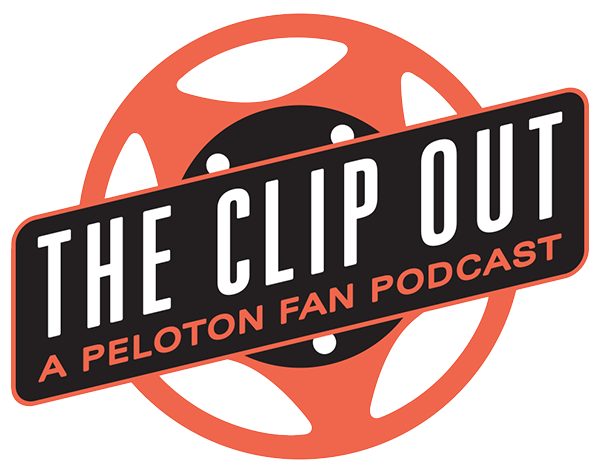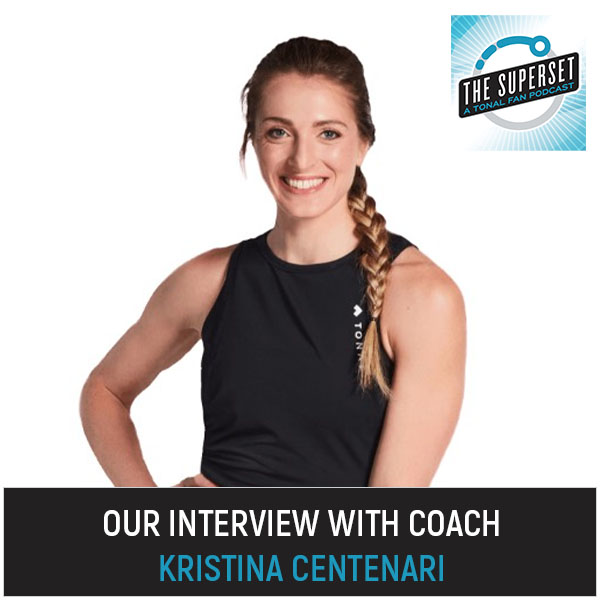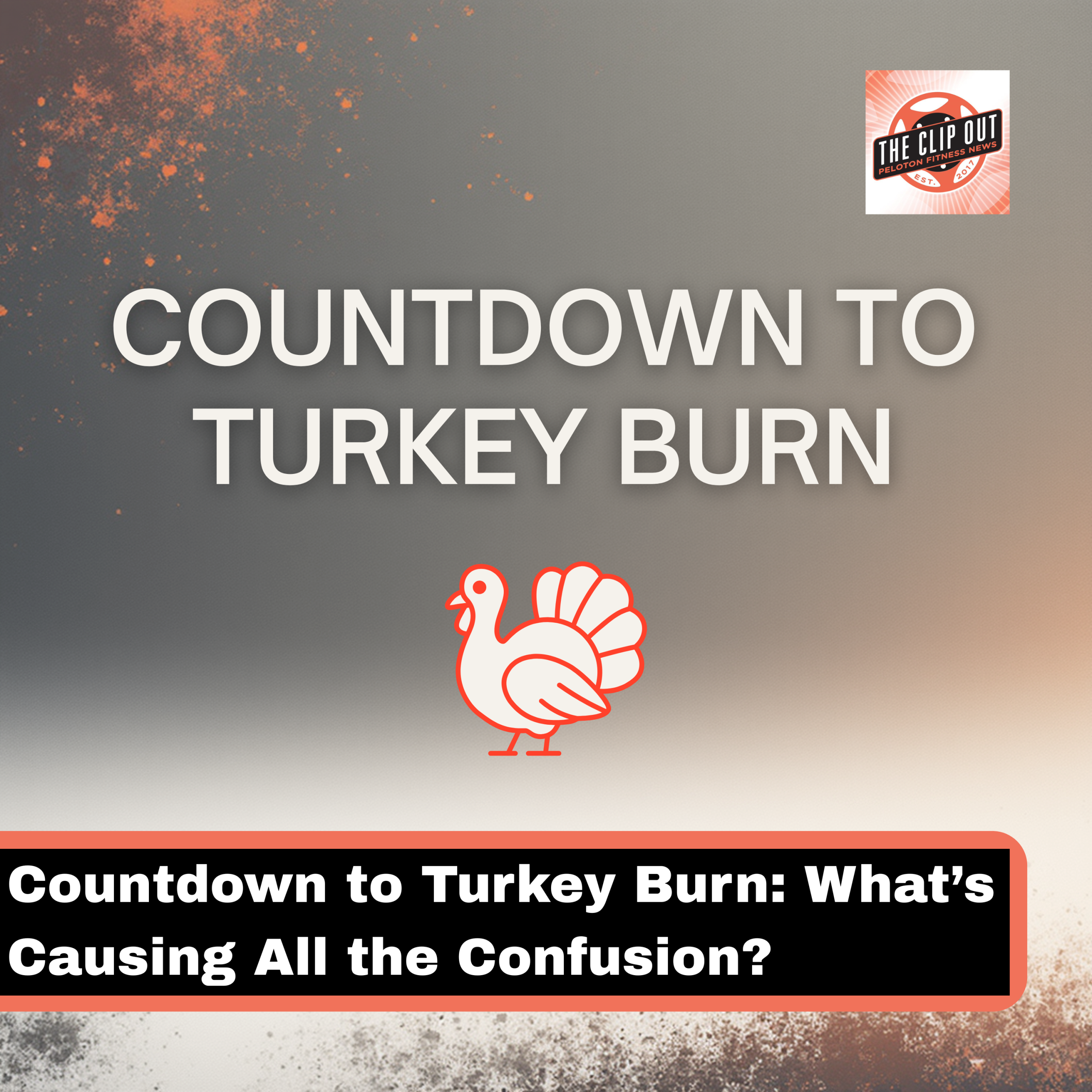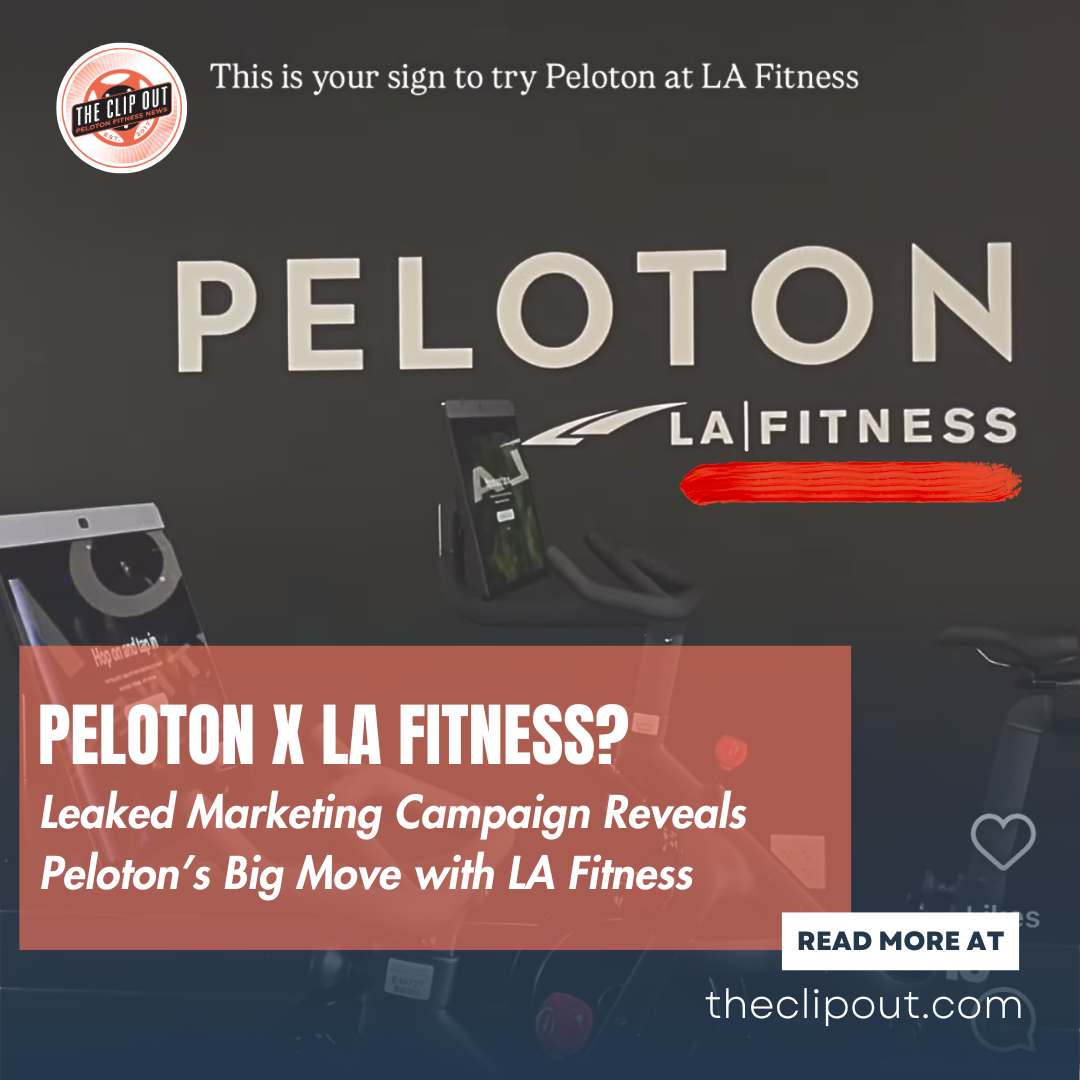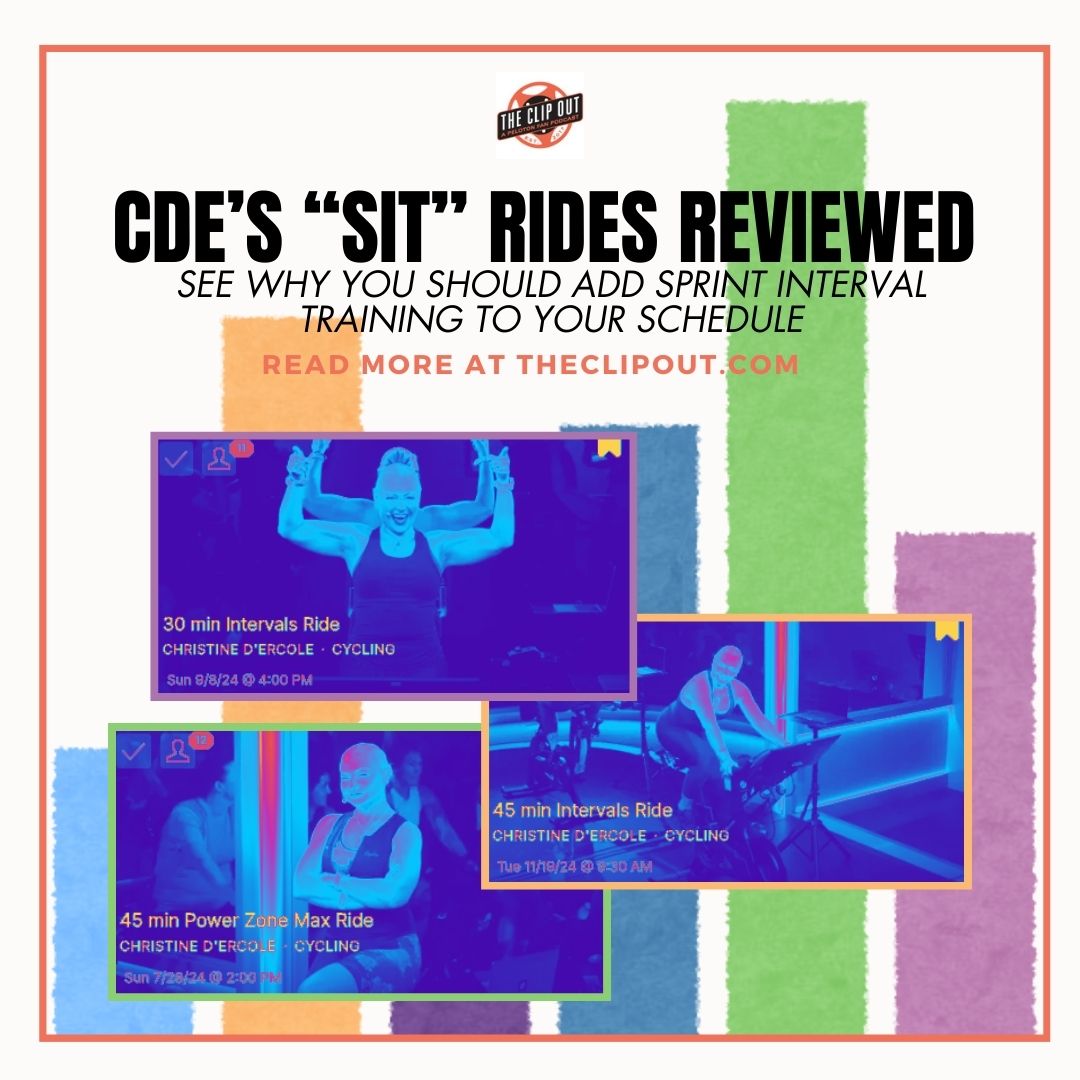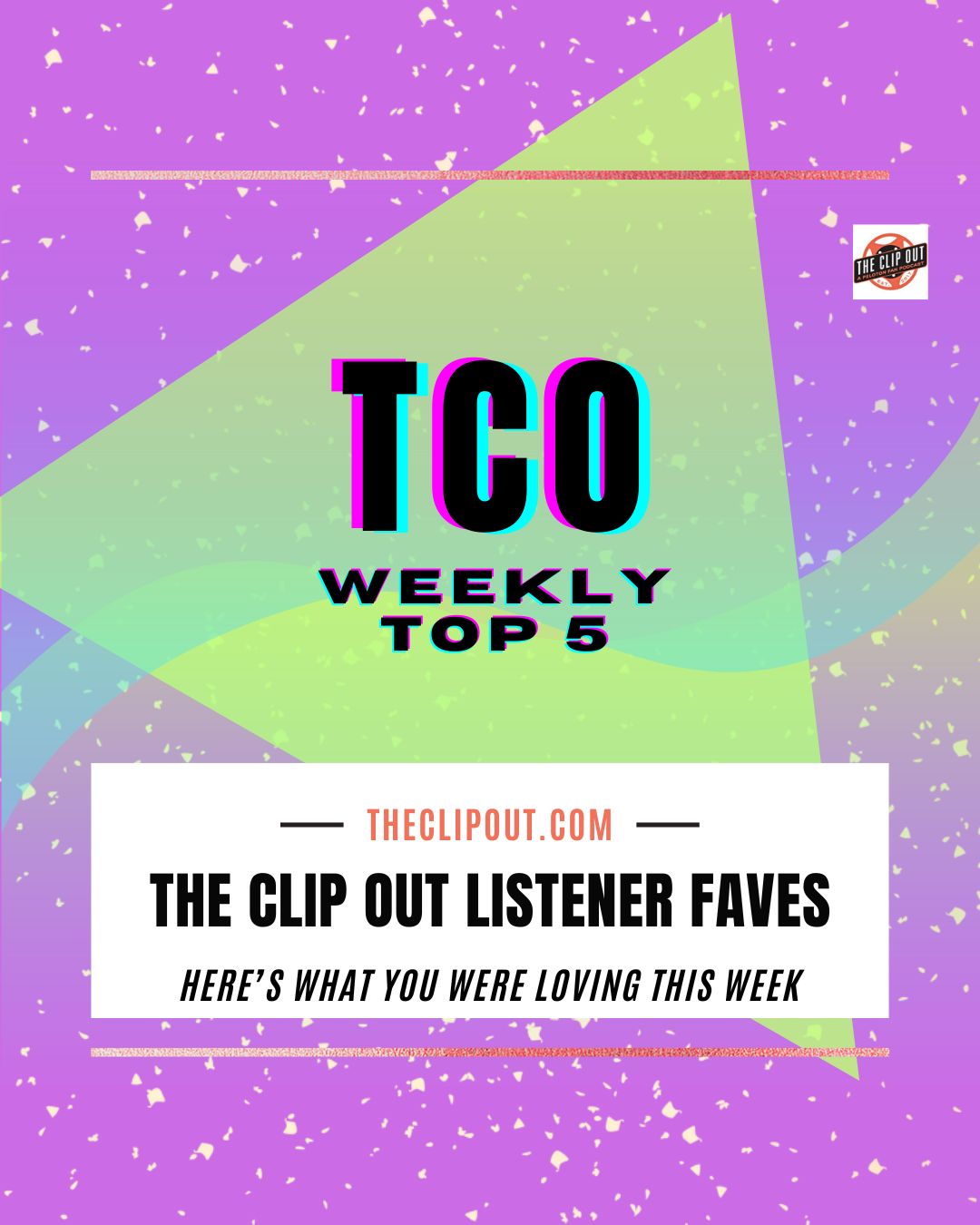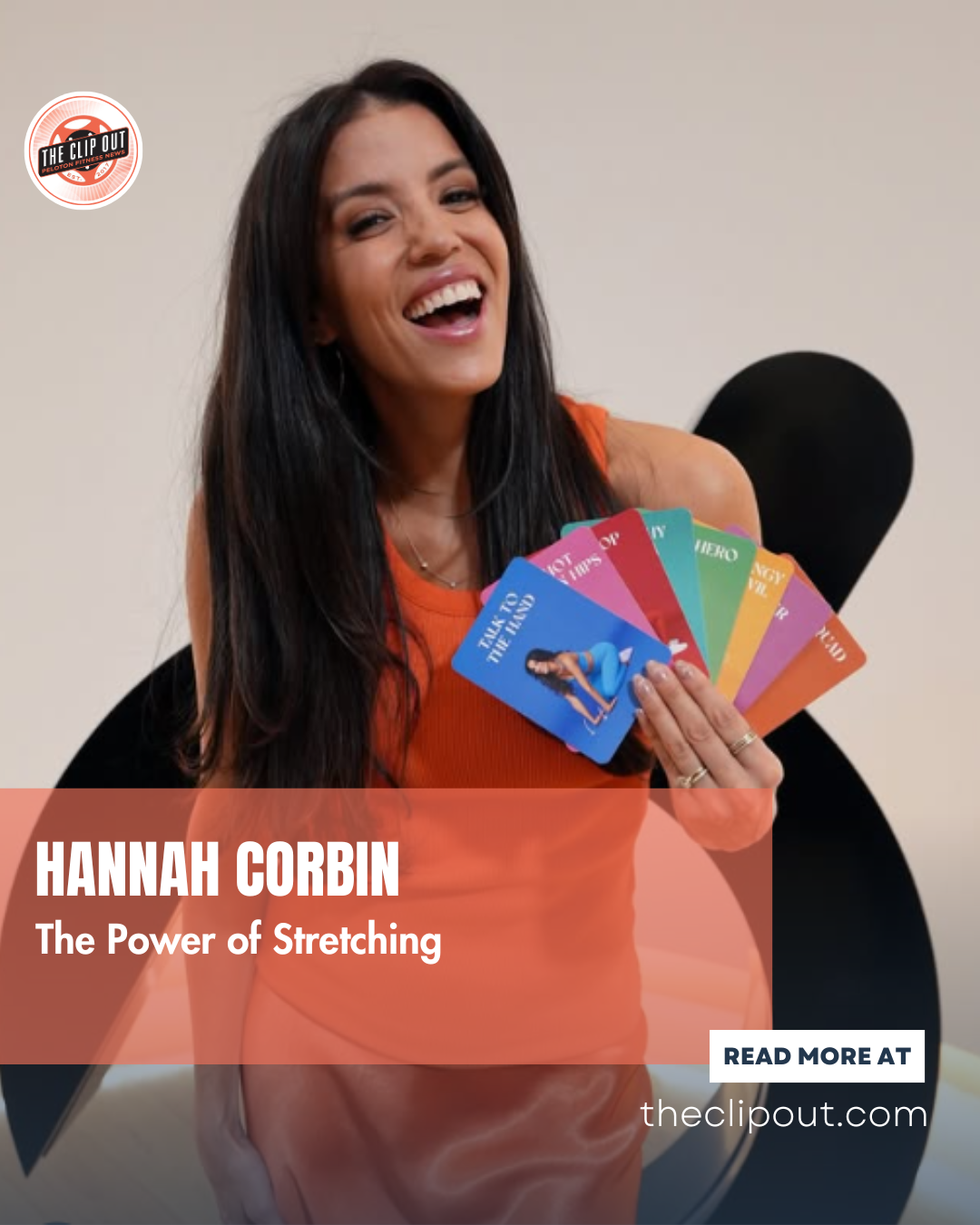Our Interview With Coach Kristina Centenari
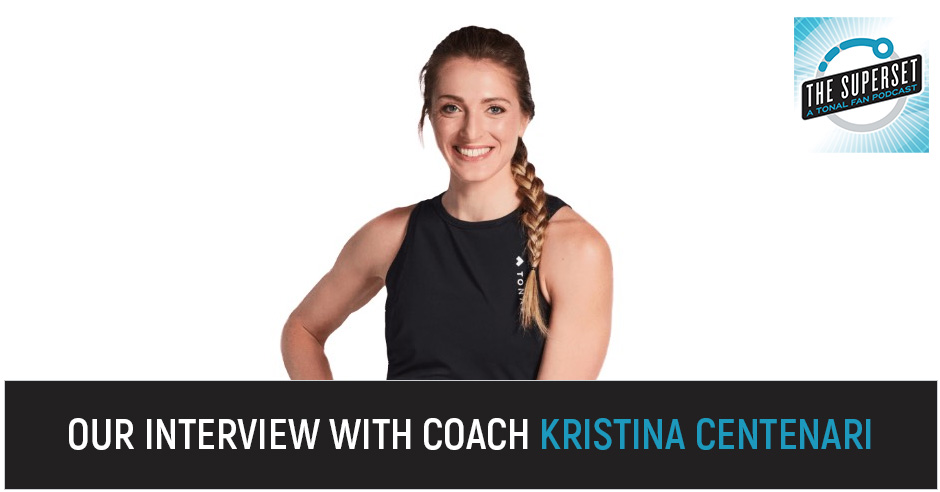
- Four Week Fast Track: Scult & Shred is here.
- New live content including 20-In-20 Spice Up, Summer Sizzle, and Pre-Season Performance.
- Joe Rodonis got engaged.
- Kristina Centenari is back to work after an injury.
All this plus our interview with Kristina Centenari.
—
Watch the episode here
Listen to the podcast here
Our Interview With Coach Kristina Centenari
Welcome to episode 52.
We both started Sculpt & Shred. The full name is Four-Week Fast Track: Sculpt & Shred. It’s a long title. Adding to the difficulty level for us on this particular one is we just got back from vacation. We spent a week at Disney. This is a first-world problem but we did not do any exercising unless you count walking. There was a lot of walking but it wasn’t walking with a purpose. Unless we thought the bus was going to leave without us, then we walked with a purpose or we had Brian walk with the purpose to hold the bus while we caught up. Let’s face it. I always say how weird I am with eating. I have the culinary taste of an eight-year-old boy at a theme park. I was literally at a theme park.
This was your place to shine.
Yes, and I shone all over the place. Now, it’s back to it because I have 12 pounds to lose.
A lot of that’s water weight and that’s going to come off.
I didn’t drink that much water.
That’s not little water weight.
There was a lot of eating. We decided to divide and conquer, which is the name of a different program but for our purposes, it’s lowercase. You’re doing the lower-body version and I’m doing the upper-body version. Between the two of us, we will either be fit or unfit.
I’m curious. Do you think that we should wait to get into our deep dive into what we think so far until later when we talk about Sculpt & Shred?
We can wait. A little tease for people.
It’s exactly what we think of this program.
Coming up is our interview with Kristina Centenari. That’s a fun one.
She’s so great.
You have that to look forward to. Also, before we kick into the show proper, we should probably remind people about the 30-Day Home Trial.
They’re trying to remind you guys that at Tonal, we have 30 days to try this at home. Did you know, and I did not know this, that 96% of members that were surveyed feel stronger after only 60 days on Tonal?
I knew that because it says it right here in the show notes.
Did you know it before that?
No.
That’s what I thought.
Did you know that 98% of members surveyed say Tonal keeps them feeling challenged?
Yeah, it says it right there too.
Did you know that before?
No.
I know a lot of people reading by virtue of definition already have a Tonal and they’re like, “Why do I care?” You probably have a friend. Trying a Tonal, I don’t feel like it’s the same as trying a Peloton. You get on a bike and you’re like, “I know how a bike feels.”
There’s so much to show a person. I work for MetPro. I’m a coach on MetPro. Several of our coaches have never even seen a Tonal in real life. We did this thing where Tonal came in virtually and they showed coaches what a Tonal can do. I kept being like, “What about this and that?” I use so much of it. There’s a high-level overview. There are so many things a Tonal does that it’s not obvious.
If you got a friend, loved one or family member that is interested in the fence, maybe remind them, “There’s a 30-day home trial.”
You can try it out for yourself.
You can test it out. They’re going to put it on your wall.
After that, no strings. They’re confident you’re going to keep it.
They’re confident you’re not going to want it off your wall. Use promo code THECLIPOUT at checkout. Save a little money.
$100 off.
We already cover everything that’s on this episode. We got some other stuff.
We’re going to talk about the new content. We’ve got our amazing interview with Kristina. There’s a whole bunch of new live classes that are coming up. We’ve got some news about the coaches so we’re going to touch on that too.
Before we get to all that, shameless plugs, don’t forget we’re available on Apple Podcasts, Spotify, Google, iHeart or wherever you find a podcast. You can find us. While you’re there, be sure to follow us so you never miss an episode. Maybe leave us a review. That’s super helpful. You can also find us on Facebook at Facebook.com/SupersetPodcast. Finally, you can watch all of these episodes on our YouTube channel at YouTube.com/TheClipOut, the name of our other show but these live there as well. We would love to see you. While we would love for you to see us, we can’t see you. It’s not how it works. We will be there in spirit in HD. There’s all that. Let’s dig in. Shall we?
We shall.
We alluded to this at the top of the episode. We started talking about it and had to stop ourselves. We were so excited. Like The Pointer Sisters, we just can’t hide it. Four-Week Fast Track: Sculpt & Shred and stuff. We started it.
It officially launched on Tonal back on June 5th, 2023 but that’s when we left for vacation.
We were on a plane while it launched.
We weren’t going to do that.
Once we got to Disney Copper Creek Wilderness Lodge, we should have done one of those 30-day trials.
Do you think that they would do that?
They’d never know.
I’m sure Disney wouldn’t be mad about that at all. Pretty sure there are rules against that.
You’re no fun.
I know. Sorry.
We’re home and we can start the sculpting and the shredding.
This has two tracks. We got the upper body and the lower body. Sculpting for the lower body and shredding for the upper body. This worked for us well because you wanted to do the upper body. I gravitated toward the lower body. Who doesn’t want to sculpt? Most women want to sculpt their lower bodies. Most men want to shred their upper bodies. It feels like a good mix.
Most women want to see the guy shredded on the upper body and most guys are focusing on the lower parts.
That was our thought process. I love this because the way that these workouts are broken out is that you have two workouts a week that are focused on strength and then you have two workouts a week that are focused on high-intensity training. I’m scared to death of what they’re going to do for the HIIT classes because the coaches have all said it’s going to be tough. That’s the whole goal. They want you to push to the next level. Not so hard that it’s not doable. I don’t mean that at all but the idea is to lift heavy.
It’s to challenge yourself.
The whole goal is to shift your body composition and to get leaner and more powerful. That was a lot of hip thrusters, like 6 sets of hip thrusters on day 1.
The upper body is the same as I was doing bench press thrusters. I do what the little guy on the screen tells me to do. I did 70 or 75 bench presses. It was over and over again.
Walking up and downstairs is going to be tough for me. I noticed that with their challenge, they have it listed out so that you have a whole month of workouts. You do these four but they also have other workouts built in that they recommend. I noticed that tomorrow is a mobility day. I’m very excited about the mobility because I can already tell I’m going to need it.
They knew what they were doing.
No doubt about it. This feels like a week when the old foam roller is going to be pulled out. Maybe the Theragun is going to have to hit all the things.
Thus far, I just finished mine. I didn’t feel completely wiped but before we left for Disney, I was doing a lot of pretty aggressive upper-body stuff for me. Maybe I had inadvertently prepared myself for this.
Whereas I have not done any strength for three weeks because of how everything’s gone down.
You were so focused on running Big Sur.
I got hit by a car.
My larger point was it messed up your routine until you got back into things.
I had started the Cycle Sync training and I liked it. It was a great program. It’s just that my cycle’s all jacked up because I’m perimenopausal. It’s not in sync. It didn’t do what it was designed to do because my body did not do what it was designed to do.
Your cycle is more Backstreet Boys.
I liked the volume and how simplistic this was. It was like, “Get in, get out, get it done.” It wasn’t like a whole bunch of different moves. It was just, “Do the things.”
Mine was 43 minutes.
Mine was 51 but whatever. No big deal.
There was not a lot of downtime. Sometimes you sit there and you’re like, “I’m ready for the next thing.” They keep you moving. It will be interesting to see how it goes as it progresses but so far so good. We will report back on the next episode in case we’re recording entirely laying on the ground.
That could happen.
There is also a lot of new live content that is coming out or has come out.
One of the ones that came out is called 20-In-20 Spice Up. This particular program uses pre-fatigue sets that you hit your target muscle group twice in a row. Do you understand that? Do you want me to explain it?
For the readers that might not be as well-versed as I am, perhaps you could explain that to them.
The idea is you go back and hit the same muscle groups twice in a row. You might do three sets and then you go of whatever move. Let’s say your bench presses. You go back and do another three sets maybe. This time, you’re going to do, let’s say pushups but you’re still hitting the same muscle groups. It burns out the muscle that you’re working on. As they say, you get the tasty burn.
That is Coach Ackeem. You’re going to get some gains from that one in a very quick amount of time. I love these 20-In-20 because they’re super short but get right to the point. We’ve got Summer Sizzle. It has a very fast pace and short rest periods but it’s all high-intensity resistance training. The idea is that you’re going to burn your fat, shift your body composition and get super sweaty. It’s perfect for you, Tom. You know how you love that.
I love the cardio.
This is Coach Woody. This is going to be a tough one. Honestly, it says that it’s high-intensity resistance training. I like high-intensity resistance training because you go fast but with weights. It’s still controlled because it’s on the Tonal. Unlike swinging weights around, I don’t feel safe with that at all. I like using the Tonal for that. You have Pre-Season Performance. This is all about improving your speed, resilience and coordination with conditioning drills. It’s all about drills, gaining power and explosiveness through heavy lifting.
This is important for people who do any kind of sports because you tend to move over and over again the same way in whatever sport you do, whether it be running, biking or football. I love this because, in Pre-Season Performance, you are working in different planes of motion so that’s awesome. If you’re a person like myself that does a lot of running and biking, you’re moving constantly forward so it’s important to move quickly sideways. That’s not something our body typically does.
If you’re a person like myself, you can do 1 of the other 2. Me in sports, no thank you. I filed a restraining order against sports.
Did you? I didn’t know that. How’s that going?
You can file a restraining order against abstract concepts but you can.
That’s only an imaginary land. This one has several coaches. I liked it when they share the coaches, Coach Joe, Ash, Tanysha and Tim. It’s four of them.
Big news for Joe Rodonis. He got engaged.
Happy engagement, Coach Joe. That’s so exciting.
Where are they getting engaged? In a Nancy Meyers film?
That’s the house where they filmed Home Alone. I’m kidding.
It looks like the set of Father of the Bride.
Maybe that’s one of those fancy bed and breakfast things. I don’t know. It’s beautiful. Woodstock Inn & Resort, that’s probably where they got engaged. I figured it out. If only Instagram had this little thing where you could tag the location.
You should write them a letter.
I should. Congratulations. That’s the point of this.
We can be on the wedding watch.
Did you see the quote that he put?
I did not.
It’s by F. Scott Fitzgerald. “I love you and that’s the beginning and end of everything.” I love it.
Am I in trouble for not having a fancy pants quote when we got engaged?
No. I still have no idea what you said to me. I don’t think you do.
I don’t either. It was like, “Here’s a ring. Do you want to?”
It was incredibly romantic. I loved your proposal so that’s not a criticism but I was so overwhelmed by everything happening because so many people were staring at us. There was a glass slipper, which is not something you see every day. You were nervous, which you never get nervous. I was focused on that.
You were afraid something was wrong.
I’m like, “What’s happening?”
For our interview on this episode, Kristina Centenari is back at work.
She had her knee injury and then surgery. You’re going to hear all about that in her interview. Coach Woody and Kristina did a video showing their reunion complete with a tear.
They attempt to replicate the dirty dancing lift.
Am I the only one that saw this and was like, “No. Don’t lift her. Your knee?”
I would go to the blog and be like, “Kristina will return in 6 to 8 weeks.”
She’s back and you can hear her whole story and recovery. She did her first live class with Coach Woody, 2 for 1, which is always fun. I love it.
You could read that right now.
—
Joining us is Kristina Centenari.
I’m so glad that you are here and that you are back on the schedule for live classes at Tonal. Welcome back. How exciting.
Thank you. I have yet to teach my first live. I was in the studio doing some other mobility units, which was good to get back in and get warmed up. I was nervous but I love this so I’m so excited to be back.
We’re excited to have you back.
Thank you.
You had an injury that put everything on hold but everybody may not know about that. Can you tell us about that injury?
I tore my meniscus in my right knee. This is perfect. I’ll say this here. Everybody thinks it was from skiing because I went helicopter skiing in January 2023, which I try to do for most years.
Helicopter skiing?
What does that even mean? Do you jump out of a helicopter?
Are you from a helicopter like in a James Bond movie?
That’s what I picture.
Are you smuggling microfiche? What is going on?
That’s my dream. Maybe if I wasn’t a Tonal coach, I’d be whatever agent. It’s very methodical. They drop you. You have a guide. They place you down on the mountain. You don’t jump but you are going up and down in the heli. You’re going to these beautiful places that nobody has been to. You’re in powder up to your chest sometimes.
That’s not skiing. That’s drowning.
I did not tear my knee there. That was a great trip. I felt great coming back but what’s interesting is that a lot of active human beings are walking around with slight meniscus tears. You can live with it. You don’t always know it. I probably from years of tennis and everything and running had something. I don’t even know exactly what it was but it was a mix.
There was one workout where I was jumping. I felt something funky. Over time, the tear got bigger. By the beginning of February 2023, I was like, “Something’s gone on here.” I got surgery in March 2023. I’m very stubborn. It took me a month. I was like, “I can rehab this. I’ll be okay.” My physical therapist was like, “We need to get it fixed. Let’s get it done.”
You know it’s time for surgery when a physical therapist says, “You got to do the surgery.”
If you can avoid surgery, I am always going to recommend it. I’ll always go to recommend the movement approach rather than cutting you open but sometimes, you got to fix it.
I’m curious about what a torn meniscus feels like.
I was too. When you said you felt something funky, I was like, “Define that in case one of us is feeling something funky and we didn’t know it.” We could be the funky bunch and not even know.
It’s a very acute feeling. What was frustrating about it is that I was still teaching, squatting and lunging but what felt horrible was bending my knee fully. That’s called full flexion of the knee and then extending it. Bending it fully and lengthening it back out, I would get this snack crackle pop that was painful, full body chills. If I was doing that, I’d get pain but pretty much anything else would feel okay. That’s why I was pretty stubborn because I was like, “I can do 85% of things.” A lot of people get used to that notion. A lot of us humans, our baseline for feeling good tends to lower whether it’s a meniscus tear or whatever feeling.
That’s called aging.
We accept these things because it’s like, “I’m getting older. These things happen.”
I was being a hypocrite because I’m always like, “No, everybody can live optimally.” We just have to put in a little work. With coaching and running, 85% is not optimal for me. At one point, I spit the bullet. I said, “Let’s do this.”
I remember seeing your post on your Instagram. You showed that you had to go to the hospital to have the surgery and then you’re starting recovery. I’ve been watching all of your recovery posts since then. What has that road to recovery felt like from your perspective? I’m not a good patient because I’m not patient.
I’ve witnessed that and I can attest that is accurate.
You’re not the only one. I’m right there with you. Patience is not my strength, let’s say. This is not the first time in my life that I’ve been injured. I ended up where I am, coaching and in the wellness space because of my past injuries. I had two other knee surgeries on my left knee, growing up playing tennis. I struggled with my right shoulder for a very long time. I’m used to being like, “We’re on the mend here. We’re about to start that journey.”
A lot of active human beings are walking around with slight meniscus tears. They just don’t know it yet. Share on XWhat was interesting about this time is it’s been a couple of years since something more serious like this happened. Knowing what I know about the body, how to train and how it works, I could use some of that and implement it in my recovery, which I’ve been trying to show on Instagram without being too like, “I’m injured. Here’s me getting better.” I was trying to make it a little bit more relatable for people, whether it’s knee surgery or anything else you’re coming back from.
The process has been a little tumultuous as all recoveries are. I’m so lucky to have this community of love, support and energy. It was a catalyst for me to go. I’m like, “I got this.” By a month and a half point, you’re not in the brace anymore or on crutches. You look like you’re walking normally but your knee is still blowing up and hindering you from doing most things. That’s where the mental patience starts to play a part because you want to get back out there.
You feel good. You see your knee. It looks okay but it’s still not there. This part of the recovery where I’m in, this second phase, is the most important, to stay patient, trust the process and work on things from a psychological and mental side. Always being in my corner and hyping myself up. It’s so easy to get down on yourself in the second phase when you think you should be further than you are.
It’s like taking antibiotics just because you’re feeling better. You got to complete the cycle. Don’t stop taking it.
You got to complete it, 100%.
The thing is that you think that you’re better. There’s this disconnect. You nailed it when you said you look at your knee and it’s fine. Your brain is like, “Why can’t you do more, knee?”
It’s this delicate balance of knowing yourself well enough and trusting who you’re working with like your therapist and doctors to be patient but also not fall into, “I’m injured.” Woody, who’s my colleague and a dear friend, said something to me at the beginning that meant a lot. She’s like, “Kristina, most of us would be sitting on our butt and being like, ‘I can’t do this and that.’”
From the beginning, I’ve been very more of the mentality of, “What can I do?” It’s easy to get stuck in the I-can’t-do-this and get used to that. The more you get used to that sedentary backing-off lifestyle, the harder it is to get back in. I’ve been trying to keep the ball rolling there. What can I do while staying smart and patient about what still needs some time?
That is smart to do. It’s great that because you’ve had experience, you had some of those things to draw on. When I was injured, that was the first ever injury that I’ve ever had in my life. It was tough mentally to come back. It’s been several months and I’m still not back where I was before. It’s hard to not feel that I should be there at a certain place. It’s nice that you’re setting such a good example of walking the walk that you put out there because people need to see that. This is the proper way to recover and put yourself in that mindset.
The first time you’re injured, it’s so easy to get very down on yourself. My advice to you having dealt with something for the first time is it’s so easy to think you’ll always be in pain. Pain is a very strong sensation. Your brain holds on to pain. It’s crazy and powerful. It’s that trust that you won’t be in pain forever. I remember my shoulder growing up and playing tennis.
I thought I was going to be in pain forever and it was so frustrating and disheartening but like anything, the more you experience something and the more you overcome it, the next time it happens, which it’s bound to because we’re human, you know. “This is what I need to do. I need to rehab it this way and think about it this way. I’ll come out the other side.” That’s the advice I would give a lot of people who are dealing with first-time injuries and pain points.
I always think you should take those fitness slogans and inverse them in those moments. It’s not that you don’t get to. It’s that you don’t have to.
You have an excuse.
Since you’ve already had two knee surgeries before that, one more and the fifth one’s free. They gave you the punch card. Did you get the punch card?
I almost got a free one.
You’re so close. How are you feeling now though?
I’m feeling good. My knee is getting there. We’re 90% there. I can’t run yet or do some of the plyometric stuff yet. When I come back teaching live, people can expect to not be doing skaters and things yet. I don’t know if that’s going to pull you into my class or if you’ll be like, “No, I want that.” We’re making strides in terms of strength. The range of motion is coming back slowly. Mentally, I’m feeling good too. It’s been up and down but you have to step back from your mind and watch it rather than sink into it. That’s what I’ve been trying to do.
If you want to get the skater to bounce back in, here’s what you do. You do an aging classic rock musician and they bring in somebody to hit the high notes. You’d be like, “For Skater Bounds, here’s Woody.”
You drink your water in the background.
When you’re done, everyone applauds for you.
I want to dig a little bit into the history you mentioned about being an athlete. You’ve done all kinds of things. You mentioned tennis but you also have played lacrosse. You’ve been in the row crew in college. Tell us about that background. I want to hear more about that.
I grew up as a tennis player, the whole family. My dad got us started. I have an older brother and a younger sister. My older brother played in college and went on to play pro for about five years after. He’s like the Buddha of the family. I’m the middle child. I’m right after him. I’m like, “I’m going to do that.” I had this shoulder injury upon my knee surgeries playing. I eventually went to college to play tennis. It was like an ACC or die. I was like, “I need the top level. I need to make it there. I need the label and the gear. I need the image.”
What does an ACC mean for u s non-sporty people?
It’s a conference. The NCAA has a bunch of different conferences depending on what area of the country your school is in. The ACC is a cluster of schools that are known for their higher athletic positioning.
It’s like Big Ten or something.
Big Ten is one conference. ACC is Atlantic Coast. I wanted to go to a school that was in the ACC. I ended up at Wake Forest and spent a little over a year there. It was very challenging because when you’re younger growing up in this culture, success is going to this school and getting this job. That’s how I grew up. Not my parents, just school and living in the States, to be honest. I have a lot to say about our culture but I had this vision of success that wasn’t going to ever fulfill me.
I go to school and put so much pressure on myself. I struggled with a lot more physical injuries and my mental health tremendously. By the time sophomore year rolled around, I thought I was okay and getting better and I didn’t. I ended up leaving my sophomore year, not having a plan on where to go. I honestly had a mental breakdown sophomore year. My dad came and picked me up and I left. I took the rest of that year off. I didn’t know that I was never going to play again but I never played again.
The more you experience something and overcome it, the more you know exactly what to do the next time it happens. Share on XI had a very strained relationship with this sport when I left. I took that year to do other things and figure out, after seventeen years of playing tennis, who am I. Who am I without it? Eventually, I went back to college, went to Chapel Hill and had a lot of fun. I dabbled in lacrosse there. I was on the rowing team for a year. I was constantly injured, which was so frustrating but like anything, it pushed me in this path.
I love being an athlete. I love moving my body. I’m good at it. I’m competitive but why am I always injured? There’s something that’s always holding me back. I didn’t realize that that is what I wanted to do then but that is always a question that I had. I’ve been in a ton of physical therapy spaces observing. When I stopped playing sports, I got into a group fit. I took a group fitness class. I was like, “Here we go. I’m going to try this out.” I was obsessed.
What was your group fitness class of choice? What did you try?
It was a small spin studio in North Carolina. That’s the first teaching gig I’ve ever done. I have a Journalism degree. I remember graduating and feeling like, “I have to go do this but I don’t want to.” One of my friends was like, “Why don’t you go do the fitness thing for a little bit? Try it out.” I moved to New York with no job. I auditioned and applied to all these different things. It eventually led me to Tonal after 4 or 5 years.
We have a son that’s getting ready to go off to college. I feel like your story is a perfect example of this. I tell him all the time, “Have a dream but be prepared to pivot. There are so many career paths out there that you don’t even know exist yet. Don’t get so hyper-focused on achieving the one that you happen to know about when you’re seventeen that everything else gets defined as a failure because it’s not a way to go through life.” Tonal and technology didn’t exist when you were eighteen. Who knew that you could have ended up at a place like this? You were prepared to pivot and try different things so you landed in something great for you.
That is such good advice for him. I am looking back at my sixteen-year-old self. If you were to tell me that, I probably would’ve been like, “Okay, Dad.” Do you know what I mean?
You’ve summarized that conversation accurately.
“You don’t understand.”
The teen attitude. It’s tough when you see your peers. This is something that I would love to change because I also think it’s contributing to our young mental health decline in a way. It is attaching your identity to a label and an outcome, thinking you have to know what you want to do next. Everything amazing and honestly, pushing me forward in my life has happened when I didn’t quite know what was next.
When I dropped my racket and took a year off, I had no idea what to do. It led me to some incredible experiences and things. When I moved to New York with no job, I had no idea what was coming next. It led me to incredible experiences and things. I was telling kids, athletes, non-athletes and whoever that being in uncertainty for a little bit and that discomfort is okay. It’s more than okay. You need it. It’s tough when you’re younger and grown up around this. It’s trial and error.
Growing up is a lot like strength training. You’re not going to grow if you don’t do some damage a little bit.
It’s an already incredibly uncertain world, at least. For me, now more than ever, the world is very uncertain. It’s hard to be in a world where you don’t have a plan. Many people talk about like, “How am I going to get this or that job?” They know they have to be self-sufficient but trying to figure out how to be self-sufficient, have health insurance and all those things are scary but you’re right. Have faith that everything will work out. That doesn’t mean don’t work hard or don’t put yourself out there. That’s how you come across cool things and get to do things like be a Tonal coach. That’s amazing.
Honestly, I feel like most people don’t have plans. A lot of times, what we think are plans is us looking back on our lives and constructing a narrative that makes it feel like we were always doing these things to end up where we ended up. When a lot of times, we did things and it happened. Sometimes people get judgmental about people who don’t have their plan. If you were honest with yourself, you didn’t have a plan. You just did things.
To Crystal’s point, you’re so working on these intrinsic qualities and characteristics. You’re still working hard, keeping yourself accountable, figuring out what that means and knowing how to be kind. I feel like growing up, people would say, “What do you want to do?” I want to be a tennis player. I want to play pro. There was no part of me that was like, “I want to be a kind person.” There’s no money in that.
At this point in my life, I have these mentors who are incredible, successful and so kind. That’s the first thing I say about them. Before I rattle off their resume and what they’ve done, I’m like, “He’s so kind.” He got to where he is because he makes people feel welcome and feel good. That’s what I say when people are like, “What do you want to do with the rest of your life?” I’m like, “I don’t know but I hope that I’m always making people feel good. I’m helping people.”
People complain a lot about cancel culture but one of the positive aspects of that is that it has incentivized kindness in a way that it didn’t before. Even if that kindness is fake, I’ll take your fake kindness out of your fear and then I will over you being a douche.
You’ve talked about your past in athletics. You’ve also mentioned so many injuries and how they’ve had such a huge impact on your career but you do a lot of work that’s based on mobility and recovery. Would you say that your training philosophy has changed during that time? Was that on purpose?
No, it wasn’t on purpose. It was one of those like we’ve been talking about. It’s one of these things that I’m like, “I couldn’t have guessed that I would be so passionate about this modality of movement.” Pain is powerful and discouraging. It impacts your life, even if it’s neck pain. It’s not fun. What drives me up a wall is when people are like, “You’re just getting older.” I’m like, “No, it doesn’t have to be that way.” You don’t have to settle for that.
I learned from my experience in addressing my injuries and honestly, poor movement patterns because if you are an elite or serious athlete, people don’t realize this but you are going to be an expert compensator like tennis. I am so good at rotating my body to one side but I am not as good at rotating it to the other side because of repetition and how many four hands I’ve hit.
Over time as a human being, that is going to impact other things, like hips and knees. Just because you move like a great athlete doesn’t always mean you move like an optimal human being. You’re going to feel it later in life if you don’t address it early. Why I’m so passionate about helping people with this is because everybody can move like an optimal human being with some of this mobility work. When you start to feel the benefits, it becomes addicting.
You’re like, “How did I ever live without this?” Knowing that your shoulders and hips are supposed to move a certain way, it’s mind-blowing at first. This is something I’m very passionate about bringing to the world. I like to think of my approach to movement as more than just fitness. Anybody can do squats for the most part. I’m more interested in the idea of performance over fitness because whether you are in the gym or not, if you’re waking up and going on with your day, you’re performing. You have to show up with your body and mind.
I’m so fascinated about how to optimize those two together to make you feel like your best and most capable self. Mobility is the foundation of movement. It’s not as fun as squatting heavily and jumping around. What’s fun is that it makes you feel better doing those things. What’s not fun is feeling pain. If I can teach people the importance of mobility, it’s so that they can keep doing those things. That’s it for me. I’d be happy. I’ll go to my grave happy.
There’s one of the questions I have when it comes to mobility and this might be because I overthink things. There are so many different kinds of mobility. You might take a Tonal class. There’s one that’s opening up your ankle joints. That’s ankle mobility and it made a huge difference whenever I took that class. How do you know, if you’re not in pain, which mobility classes you should be focused on for you? How often should you be doing this? There are so many different kinds.
First and foremost, I would like to stress the fact that mobility is different than stretching. We tend to throw this vocabulary around, “Open up and loosen up.” Most people, understandably, think that means holding a deep stretch, which is not a bad thing. There are a lot of people who need a more passive range of motion, in which case you would be holding a stretch, passively.
Mobility, for a lot of people, is going to be more active. It’s going to feel like work. It’s going to be uncomfortable. You might even get sweaty. Make sure that you’re taking classes that are more than stretching. Strength training for your joints is how I like to think of mobility. If you think of your body as parts of your body, this is a little bit overgeneralized but you can think of three different main parts.
You’ve got your spine. I have some classes out that are spine and shoulders. When you’re working with your spine, it’s a little bit of a different joint. You’re working through different exercises but still working range of motion and strength in your spine. You think of the spine, upper body or shoulders. Shoulders are going to be the main foundation for upper body things, and then hips. Thinking of those three categories, spine, shoulders and hips usually will address other joints within that. Whether you’re feeling pain in one of those areas or not, that’s a good way to approach what class you want to take.
You can also think about it as if you want PR your squat or deadlift, go take a hit mobility class. It will translate into heavier lifts if you’re focused on a more specific lift. My biggest advice is to think of the body as three sections like that when it comes to mobility. If you’re struggling with pain in one of those sections, take that class, spine and shoulders or hips. You can think about it as, “What are my specific goals in my other lifts? Do I want to squat more? Do I want to improve my pushup?” Get your quads working better if you want to improve your pushup. In which case, take any.
If you are an elite athlete, you will actually become an expert compensator. Share on XAre the mobility workouts typically lower impact in terms of the volume of weight that you’re lifting? My question is, would they make a good recovery day for people?
Yes.
That’s good to know because a lot of people, especially boys, let’s put it out there, get focused on the weight that they’re like, “If I’m not lifting weight, what am I doing?” That’s a good example of if you’re not supposed to work out that day anyway from your muscle readiness standpoint, then throw mobility. At least you’re still doing something and you’re not “wasting” your time when you could have been doing something else.
You hit it right there. I’m smiling because, in my history as a trainer and a coach, I’ve trained a lot of men, bigger men and elite male athletes who have that mentality. If they’re not going hard or lifting heavy, then what are they doing? I have somebody not touching Tonal or a weight. I show them, “This is what it means to have strength within your hip capsule,” for example.
“If you want to PR your squat, go ahead and stand here for me. Lift your knee to your chest, hold it there and I’m going to try and push your knee down. Fight me.” I’ll have these big elite men not able to resist me as I push their knees down with the strength of their hips. No crazy external weight. It’s just their hip capsule. Your hip capsule is different from these big muscles in your glutes, quads and hamstrings.
What that movement is doing is essentially the same thing as a squat. You’re lowering yourself down in a squat and your knees are moving up towards your chest. If I’m trying to push that knee down and your hip capsule can’t do it or you’ll start cramping right away, which is usually what happens, it’s very eye-opening for people to realize, “That is what foundation means. I’m lifting all of this weight. I’m wondering why something hurts but I can’t even resist Kristina’s hand if she’s trying to push my knee down.”
Using it as a recovery is a beautiful option. It’s not fun but I would encourage it. It’s like your vegetables. Make sure you’re doing it once or twice a week, maintenance work. Make sure you’ve got all these puzzle pieces together, the engine is oiled and then go do the fun stuff. My mobility classes are 10 to 20 minutes max so you’re in or out.
It’s like a pyramid. Everything’s goal-oriented. That athlete started lifting weights so they could hit the ball farther. You’re going to do this so you can lift the weights more and hit the ball farther. It’s a chain of events.
We say pick your kid or grandkid up when you’re older. Certainly, it’s strength training. Raise your arms over your head and hold that weight. Get your mobility work in there as well. There’s a difference between lifting a kid, holding them here and being able to lift your arms overhead.
I feel like you shifted from kids to grandkids in that analogy because of me. I feel a little called out.
I’m supporting the notion of it’s not about getting older. It’s about continuing to be consistent.
I am curious, Kristina, when you were going through this process of rehabbing. You’re still recovering. It takes a while as you said. How did you train on Tonal as you went through this process? Did you adjust or change anything?
I pretty much got on Tonal immediately. If somebody was like, “Go,” I would go do an upper body workout on Tonal but the first week, I had to minimize all movement. By the second week, I was still in my big fat leg brace and on crutches. I did the upper body. It was incredible because I have this in my apartment in my living room. I can’t even walk outside yet for that long but I can sit on the bench and do shoulder presses and rows. I adjusted certain movements that maybe were standing where I sat down and did them instead.
A standing chop, I still got that core rotation but I sat. It was awesome. I don’t want to say it was easy but I would have to Uber to the gym if I wanted to go to the gym. This was so wonderful to understand that when you don’t have something working, you can still make a lot of work. I did mostly upper body for a couple of weeks until I could stand.
When I could stand, I still was in my brace and I wasn’t with anything from the waist down, no squatting and no hinging but I was standing and that was enough of stimulus for my knee to start to understand, “Let’s get this strength back standing while we’re doing a bend over a row.” I started sprinkling more in there. I remember when my physical therapist was like, “You’re cleared to do an RDL. Your hamstrings can lengthen safely. Keep it light.”
I immediately went home. I got on Tonal and did some RDLs. It was incredible. After a couple of weeks of not being able to do that, it was great. I was able to adjust my weight. There were a lot of workouts that I did in active recovery mode. Sometimes, I would have to even adjust it lower and it’s fine. There’s no ego over here. There was when I was younger. I got it all out though. I take that back. Sometimes with Coach Joe, I have a little bit of an ego. I’ll get a little competitive but otherwise, no.
What do you feel like you’ve learned? What has stuck out the most to you as you’ve gone through this process?
I knew this but I didn’t know it well enough to be able to give it as advice. When you are recovering from an injury, it takes time to heal but you also have to do the work. You’re not going to feel like it a lot. You get used to not doing anything. Human nature generally wakes up and gets used to not doing anything.
It’s crazy how fast you can get used to that.
It’s scary and it causes a little bit more anxiety when you know it’s time to start going again. Keep it small but get the reps in. Make sure that you’re staying consistent. In the very beginning, I had this exercise in which I was trying to straighten out my knee as much as I can and then let it bend again. I straighten it out as much as I can and let it bend again. I would be doing that as much as I could, just as something for my brain to be like, “You’re putting in the work here.” My biggest piece of advice is to move into this with the approach of, “What can I do,” and do it. Trust yourself and the process.
Do your future yourself a favor.
One last question, you mentioned no plyometrics. We could expect your live classes with no plyometrics. Is there anything else that we should be expecting as you come back to Tonal and start teaching live again?
I’m very excited about it. There will be no plyometrics but we are still going to be working on muscular endurance. It’s a very different program that I’ve been creating that I’ve been wanting to do. It’s such a wonderful opportunity to do it but I’m going to teach you how to challenge yourself with your body weight and then make sure that you’re still focusing on movement quality when you overload on Tonal. It’s going to be a great first program back. We’re getting close to the marathon season in the fall of 2023. People can expect some of that focus coming up and moving forward but like my 20-in-20 for Runners last time.
I loved that program. I’ve taken it and I am a coach for MetPro. I have suggested that to so many people. It’s perfect. I love it.
I’m beaming. That makes me so happy. It’s a palatable twenty minutes. It’s easy to stay consistent with your running volume. Also, I always say, you do not have to be a runner to do it. It will benefit your running if you are but if you’re not, it’s a beautiful program and a wonderful workout. My point is more things like that to look forward to. There’s so much mobility of fun on first coming back.
I know Crystal said the last question but I have one more question. If you have convinced someone that they want to do a mobility workout but they don’t feel like they have an immediate pressing knee, they don’t have knee pain but they want to start incorporating to get out in front of things, where would you recommend that they begin?
I would first applaud them because it doesn’t have to be you being in pain to do it. Second, my answer and whether this is super helpful or super not helpful, is literally any. Any of my mobility classes that you see on Tonal will benefit whatever joint/collection of joints we are focused on. There are a couple that I’ve named like full body maintenance or One-Stop Shop. Those names of sessions and units might be good for somebody for that to be your first one. Any of them, you’re starting to build the body awareness and that’s where you start. You dive in. You figure out what it means to have a working shoulder and be able to move your ankle the way it’s supposed to move. That’s my advice, just any of them.
When recovering from an injury, you still have to do the work. Fight off the feeling of being comfortable not doing anything. Share on XYou don’t dive in. You helicopter dive in.
You sat down on the mountain.
Bring it all full circle.
Go and get work.
Thank you so much for taking time out of your busy day to talk to us and share all this wonderful information. Before we let you go, let everybody know where they can find you on the interwebs.
I am on Instagram @Kristina_Centenari. That is pretty much the only social media platform I have bandwidth for at the moment. That’s the best place to find me but shoot me a DM. To be transparent, whether it’s a DM, a text or an email, my response time is a work in progress. I am here for questions. Honestly, it fills me up. It’s truly the root of my why. When people are reaching out to tell me their stories, I can’t welcome that enough. Instagram is where you can find me.
Thank you again for doing this. We appreciate it. It’s been such a great experience getting to know you and hearing more of your story. I appreciate everything that you have shared.
Thank you so much for having me on. I had so much fun.
Us too.
—
That brings this episode to a close. Until next time. Where can people find you?
People can find me on Facebook at Facebook.com/CrystalDOKeefe. They can find me on Instagram, Twitter and the Tonal leaderboard, @ClipOutCrystal.
You can find me on Twitter @RogerQBert or Facebook at Facebook.com/TomOKeefe. You can find the show online at Facebook.com/SupersetPodcast. While you’re there, like the page and join the group. Don’t forget to check us out on YouTube. That’s it for this one. Thanks for reading. Until next time. Keep lifting.
Important Links
- Apple Podcasts – The Superset
- Spotify – The Superset
- Google Podcasts – The Superset
- iHeart – The Superset
- Facebook.com/SupersetPodcast
- YouTube.com/TheClipOut
- Kristina Centenari – Instagram
- MetPro
- Facebook.com/CrystalDOKeefe
- Instagram – Crystal O’Keefe
- Twitter – Crystal O’Keefe
- @RogerQBert – Twitter
- Facebook.com/TomOKeefe
Love the show? Subscribe, rate, review, and share!
Join The Superset community today:
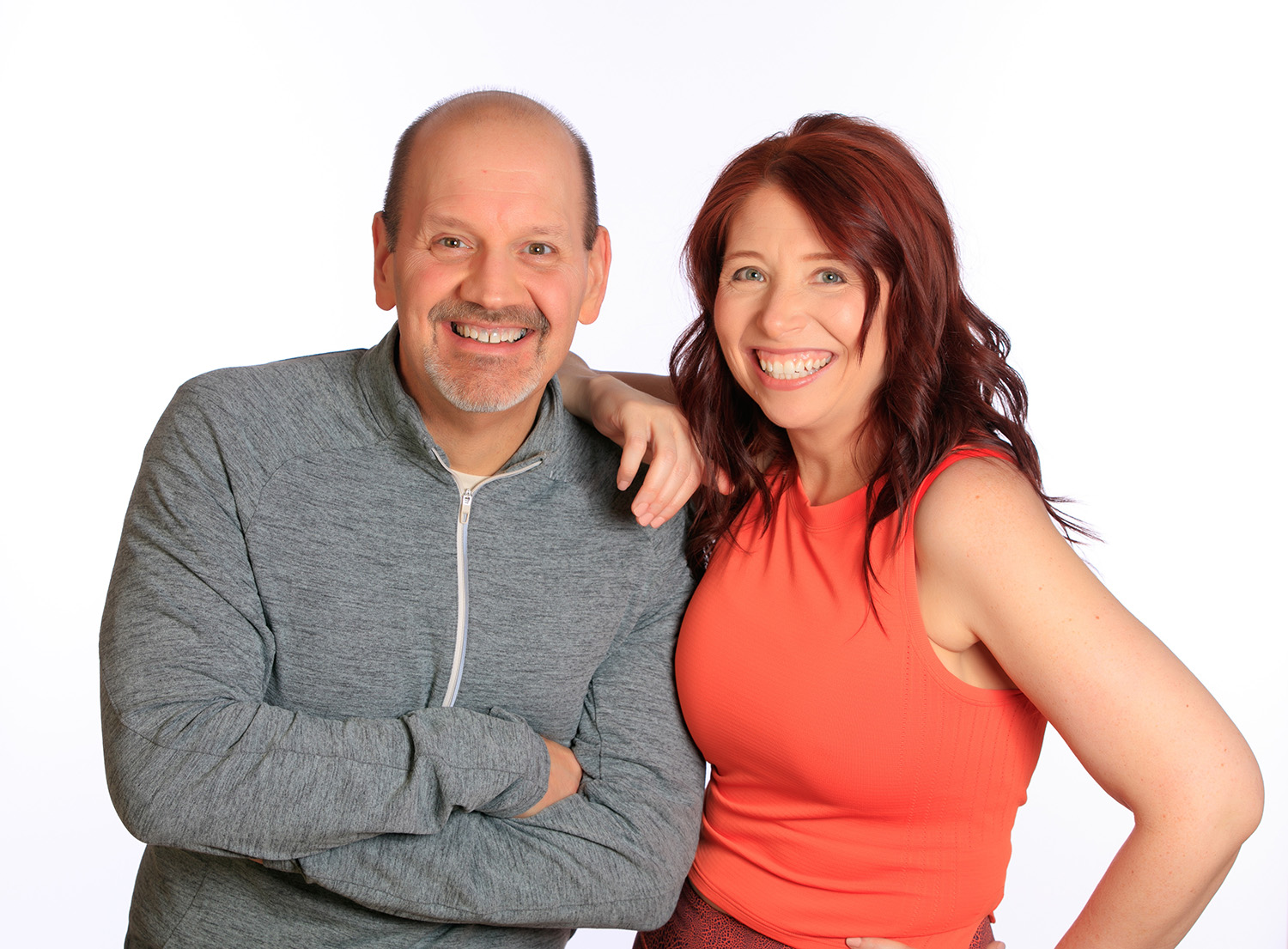
Subscribe
Keep up with all the Peloton news!
